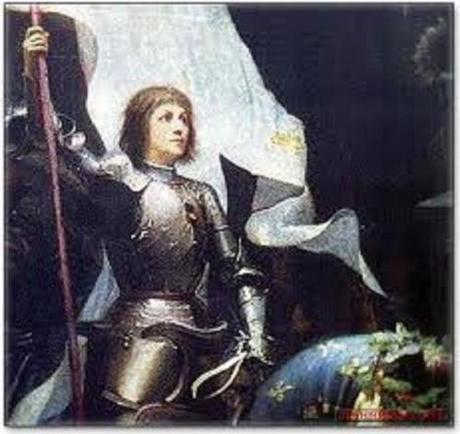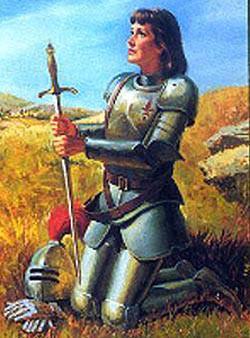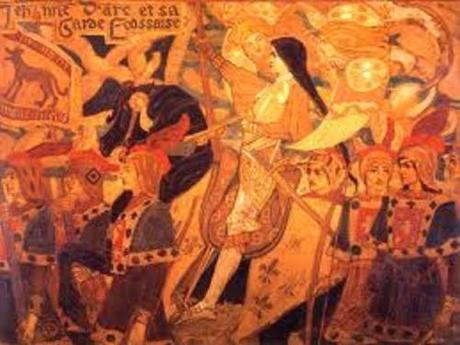 Today, May 30th, is the Feast Day of St. Joan of Arc, my favorite saint.
Today, May 30th, is the Feast Day of St. Joan of Arc, my favorite saint.
St. Jeanne La Pucelle was born in Domremy, a small village of Champagne, on the Feast of the Epiphany, January 6, 1412, to Jacques d’Arc, her father, a peasant farmer who was a leader in his community, and to Isabelle, her devout mother. Isabelle taught Joan her Catholic Faith and her prayers. Joan was a pious young person, who loved to pray and receive the Sacraments, Penance and the Holy Eucharist. She was very kind, having cared for individuals who were sick and helping people who were wanderers, offering them her bed so that they might rest. She enjoyed her childhood and was most proficient with the household chores, wherein she loved to sew and spin. Joan said, “I fear no woman in Rouen at sewing and spinning.”
Joan lived in the throes of the Hundred Years War. King Henry V of England invaded France, took over Normandy and claimed the crown of Charles VI of France. To make matters worse, there was also a civil war between the Duke of Burgundy and his allies and Orleans. The Duke was murdered and thereafter, the Burgundians allied themselves with the English. France was literally falling apart, with town after town falling to the English and/or the Burgundians. In the meantime, the new individual who should be king, was Charles VII, known as the Dauphin; he did little to help France’s dire situation.

When Joan was 13 years of age, Joan saw St. Michael the Archangel, who comforted her and told her not to be afraid. She then saw Sts. Catherine and Margaret, telling her about her mission from the King of Heaven, to save France advising her that she must lead the army of France. Joan stated in testimony:
“When I was thirteen, I had a voice from God to help me to govern myself. The first time, I was terrified. The voice came to me about noon: it was summer, and I was in my father’s garden. I had not fasted the day before. I heard the voice on my right hand, towards the church. There was a great light all about.
I vowed then to keep my virginity for as long as it should please God.
I saw it many times before I knew that it was Saint Michael. Afterwards, he taught me and showed me such things that I knew that it was he.
He was not alone, but duly attended by heavenly angels. I saw them with the eyes of my body as well as I see you. And when they left me, I wept,and I wished that they might have taken me with them. And I kissed the ground where they had stood, to do them reverence.
Above all, St. Michael told me that I must be a good child, and that God would help me. He taught me to behave rightly and to go often to church. He said that I would have to go into France.
He told me that St. Catherine and St. Margaret would come to me, and that I must follow their counsel; that they were appointed to guide and counsel me in what I had to do, and that I must believe what they would tell me, for it was at Our Lord’s command.
He told me the pitiful state of the Kingdom of France. And he told me that I must go to succour the King of France.
St. Catherine and St. Margaret had rich crowns on their heads. They spoke well and fairly, and their voices are beautiful-sweet and soft.
The name by which they often named me was Jehanne the Maid, child of God.
They told me that my King would be restored to his Kingdom, despite his enemies. They promised to lead me to Paradise, for that was what I asked of them.
Twice and thrice a week the voice told met hat I must depart and go into France.
And the voice said that I would raise the siege before Orleans. And it told me to go to Vaucouleurs, to Robert de Baudricourt, captain of the town, who would give me men to go with me.
And I answered the voice that I was a poor girl who knew nothing of riding and warfare.”
Joan went three times to speak to Robert de Baudricourt about the instructions she received from the King of Heaven. On the third occasion, Baudricourt listened to Joan, as a previous prediction she had made to him regarding a defeat for the French army came true. Accordingly, Baudricourt gave Joan an escort of three soldiers to protect her, to present herself to Charles VII. Joan travelled wearing the clothing of men and reached Chinon on March 6, 1429. The Dauphin disguised himself to see if Joan would be able to point him out amongst the other individuals in his Court. Of course, Joan identified the real Dauphin. She spoke with him in private and gave him a secret message told to her by her heavenly messengers, which convinced Chales that what Joan said was true. He gave her soldiers so that she could lead them towards the relief of Orleans. However, this decision came with opposition from some of the members of Charle’s court. Therefore, she was sent to Poitiers to be examined by a learned body of theologians. After extensive questions and a thorough investigation, these theologians found Joan to be pure and true, finding no fault with her. Indeed, they advised Charles to use this pure human being for the good of France.
After Joan returned to Chinon from Poitiers, she was equipped with an expeditionary force, and she was provided with white armor and other supplies, with a banner or standard which was Joan’s favorite possession. Upon the banner was a representation of God the Father to whom two kneeling angels were presenting a fleur-de-lis, with the writing upon it, “Jesus:Maria”.

Joan the Maid was then allowed to lead the French army in yet another campaign on the Loire with the Duc d’ Alencon, one of her dearest friends. This campaign was successful, and she ended with another victory at Patay in which the English forces suffered yet another defeat.
On July 17, 1429, Charles VII, the Dauphin, was crowned with Joan beside him holding her treasured banner. Joan was successful in this important campaign. Nevertheless, troubles ensued and she went to the relief of Compiegne which was holding out against the Burgundians. On May 23, 1430, because of some miscalculation, the drawbridge over which her company was retiring was raised too soon, leaving Joan and some of her men outside at the mercy of the Burgundians. She was taken by the enemy and remained the prisoner of the Duke of Burgundy. Charles, the Dauphin, did not come to Joan’s aid during the entire time of her imprisonment. Clearly, he betrayed her. On November 21st she was sold to the English. They knew that they could not condemn her for her defeat of them in war, but contrived that they could harm her if she was tried as a sorceress and a heretic.
Joan was in prison in the castle of Rouen. On February 21, 1431, she appeared before Peter Cauchon, who was Bishop of Beauvais, who hoped that through English influence he could become the Archbishop of Rouen. This Tribunal consisted of Cauchon, dignitaries and doctors carefully selected by Cauchon, as well as of the ordinary officials of an ecclesiastical court. During the course of her sessions, Joan was examined and cross-examined as to her visions and her voices, her assumption of male attire, her faith and her willingness to submit to the Church. Joan answered their questions boldly. Her answers were not only cogent, but logical and embarrassing for her inquisitors. For example, when Joan was asked whether she would refer herself to the determination of the Church, she stated:
“I refer myself to Our Lord who sent me, to Our Lady, and to all the blessed saints in Paradise. It seems to me that Our Lord and the Church are one and the same, and that no one shold make difficulties about that. Why do you make difficulties about its not being one and the same?”
Joan further reiterated this comment stating her allegiance to the Church and also stating, “Our Lord first served!”
This alleged unfair tribunal summed up her answers as revelations from the devil wherein these misrepresentations were submitted to the judges and then to the University of Paris. Joan was denounced.
The tribunal decided that she must be handed over to the secular arm as a heretic if she refused to retract. In a final attempt to obtain her admission and retraction, Joan was threatened with torture. She, out of extreme fear, made a retraction of her testimony. She was taken back to prison. Joan knew that her retraction was wrong, and again put on the male attire that she wore as a soldier for France even though she was expected to discard this dress. Cauchon and his assistants visited Joan in her cell and saw what she had done, noticing that she had recovered from her previous weakness. Therefore, Joan again declared that she was sent by the King of Heaven and that the voices of the saints she heard came from Heaven also.
On May 29, 1431, the judges heard Cauchon’s report, condemning Joan as a relapsed heretic to be delivered over to the secular arm.
On May 30, 1431, the 19-year-0ld Joan was fastened to a stake being prepared to be burned upon it. A Dominican friar at her request held up a cross in front of her eyes, and as the flames lept upon her, she cried, “Jesus, Jesus”. Some of the people cried that they had burned a saint. Her ashes were hurled into the Seine.
Twenty-three years later, Joan’s mother and her two brothers appealed to Pope Callistus II to have her case reviewed. The Pope granted this request and appointed a commission to review what happened, to examine the witnesses and review the written testimony. On July 7, 1456, the trial was declared biased and unfair, quashing the trial and its verdict, completely exonerating dear Joan.
Four-hundred and fifty years later, on May 16, 1920, Joan was canonized as a saint with all solemnity, by the Catholic Church. She is the Patron Saint of France, of soldiers, of military personnel and of prisoners.
St. Joan is very dear to me as she has helped me so much in my life. It is my hope that I will also live my life with kindness, courage, bravery and loyalty, and putting my Faith first above all things, loving Our Triune God with great passion and zeal. She is an example of a pure young lady, full of love for God, for His Church and for his people. Yes, dear brave Joan, may Our Lord always be first served!
With love, reverence and respect for St. Joan,
Joan
Sources:
Butler’s Lives of the Saints, Edited by Michael Walsh
One Hundred Saints, Bulfinch Press AOL Time Warner Book Group
Joan of Arc In Her Own Words, Compiled and Translated by Willard Trask; Afterword by Sir Edward S. Creasy

